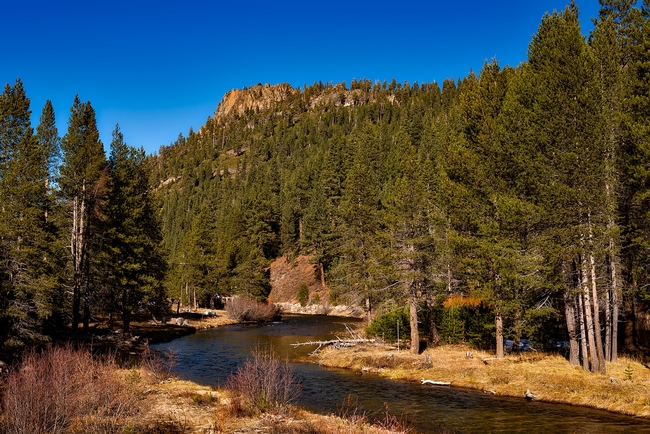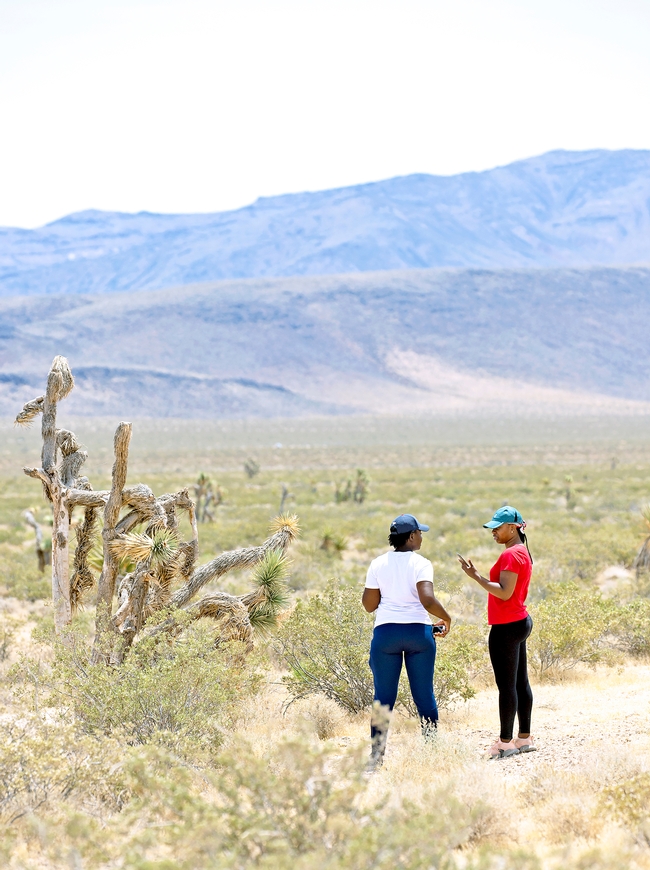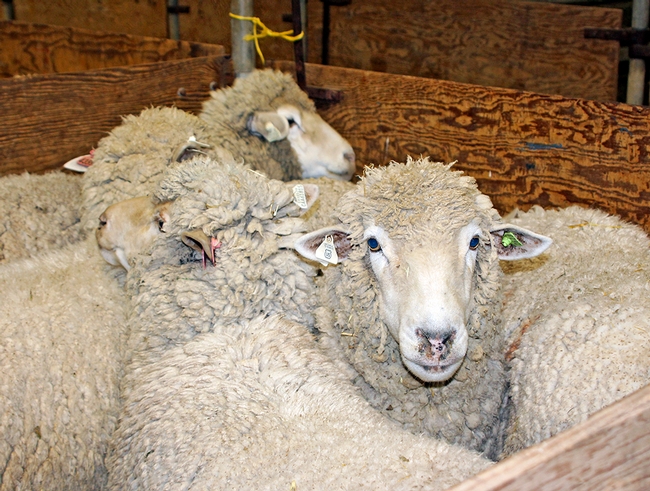Posts Tagged: bird
UCCE promotes nature as a way to improve wellness
Many Californians' well-being has suffered after months of sheltering at home amid the coronavirus pandemic. An antidote for the boredom, loneliness and uncertainty is spending some time outdoors, according to UC Cooperative Extension experts. It's a practice that renews the spirit and can easily be done while following social distance and face covering requirements.
A few 4-H youth camp programs have gone virtual, but for most 4-H members the annual trek to summer camp has been cancelled. 4-H Youth Development advisor Marianne Bird is encouraging 4-H members and families to get outside on their own.
“Being outdoors is something healthy to do,” Bird said. “Public parks are being used more and in safe ways. I see groups of people social distancing and eating lunch in the shade, bringing a lawn chair and sitting outside. Two weeks ago, I saw someone playing violin next to the American River bike trail.”
This month, Bird is teaming up with two colleagues for socially distanced camping for a few nights in the Sierra. They'll drive separately and sleep in separate tents, while they hike trails, swim in a lake and enjoy the night sky at least 6 feet apart. But even in her hometown of East Sacramento, Bird said she finds nature that promotes her well-being.
“I ride my bike on the American River trail. I see wild turkeys, jackrabbits and coveys of quail,” Bird said. “Walking in my neighborhood, I found a woodpecker home in a tree. Nature is everywhere, even in our urban environment.
UC Cooperative Extension assistant vice provost Katherine Soule conducts research on the benefits of outdoor activities. She and colleagues surveyed visitors at the Leaning Pine Arboretum in San Luis Obispo. Respondents said the garden visits wove together opportunities for learning, stress relief and relaxation, which enhanced the visitors' enjoyment of life, their self-awareness and their sense of belonging.
One participant mused, visiting a botanical garden “feels open, not cramped. In my mind, that's part of being outdoors. Outside you want to be free, open. I enjoy it.”
UC Cooperative Extension's California Naturalist program is including research-based information on the health benefits of nature exposure in its soon-to-be launched UC Climate Stewards program, according to Sarah-Mae Nelson, UC Climate Stewards Initiative academic coordinator. The pilot training program that begins Aug. 24 teaches volunteers to educate the community on climate change mitigation, adaptation and resiliency,
Trainees will learn about research conducted around the world that has documented the restorative capacity of nature, Nelson said. For example, a 2010 research project in Japan found that spending time in forests lowered blood pressure, cut levels of cortisol – commonly known as the “stress hormone” – and reduced pulse rate, among other beneficial health impacts.
Benefits were derived from visiting zoos and aquariums, according to a 2010 study in Japan and a 2015 study in England. Just working in the presence of potted plants reduced stress and increased productivity, found scientists in Australia. Researchers in the Netherlands discovered that simply gazing at photos with trees and parks can prevent and relieve stress.
“What's really encouraging to me as an educator and communicator is the evidence for zoos, aquariums and images as proxies,” Nelson said. “Right now, with the situation with COVID-19, people can't access nature as readily. And, looking at the diversity, equity and inclusion aspect, some people don't have the financial or social capability to enter into natural spaces.”
Another study that is shaping the UC Climate Stewards curriculum, conducted in England and published last year, indicated that spending at least 120 minutes in nature provides a significant positive impact on mental and physical wellness.
“After 120 minutes, the participants felt less depressed and had an increased ability to deal with stressful situations,” Nelson said.
For that reason, the 120-minute threshold number for nature exposure will be part of the UC Climate Stewards' approach to reduce the effects of traumatic stressful experiences, like those brought on by climate change concerns.
The Butterfly and the Bird
A monarch butterfly fluttered into our pollinator garden in Vacaville yesterday and sipped nectar from a Mexican sunflower (Tithonia) as a bird...
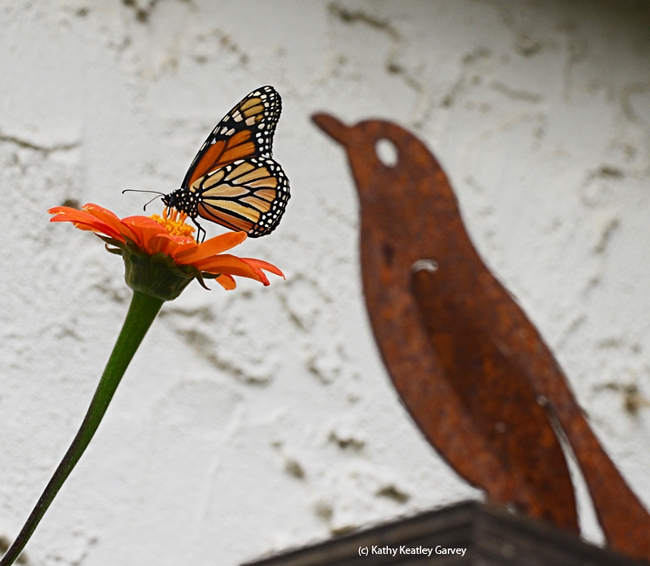
A monarch butterfly sips nectar from a Mexican sunflower (Tithonia) in front of a bird, decorative art. (Photo by Kathy Keatley Garvey)
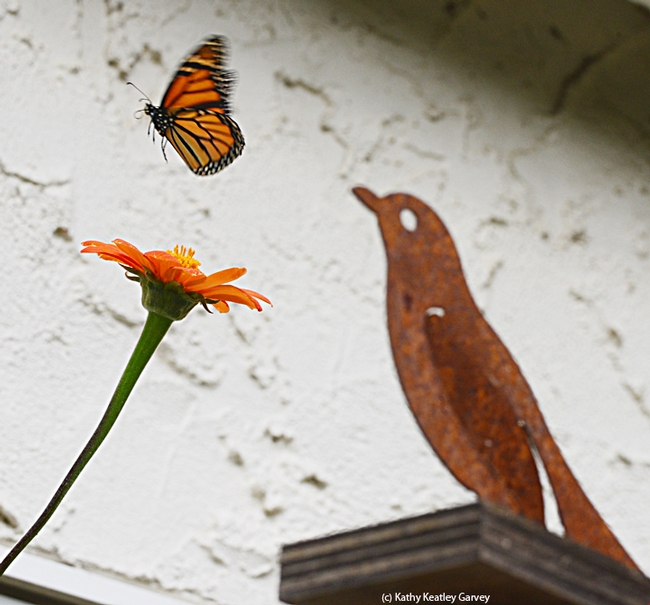
Up, up and away--but not because the bird was a threat. (Photo by Kathy Keatley Garvey)
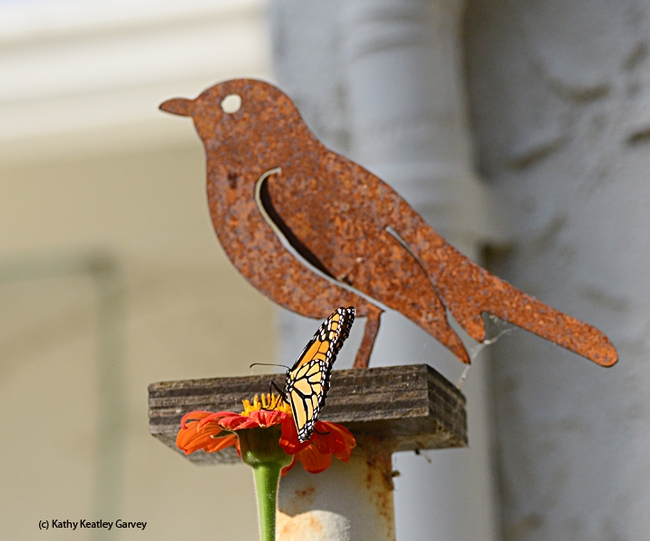
The monarch returns to the bird sighting, this time to sip nectar by its feet. (Photo by Kathy Keatley Garvey)
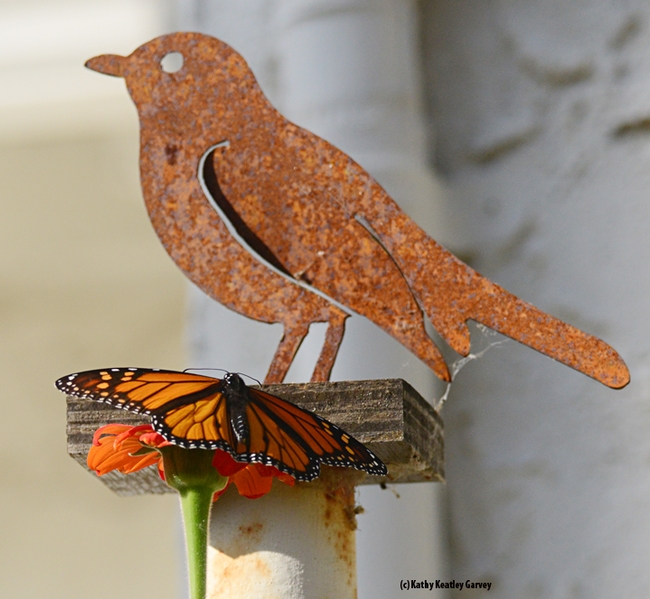
The monarch spreads its wings. The bird cannot. (Photo by Kathy Keatley Garvey)
What You May Not Know About Hummingbirds
Pollinators aren't just bees, butterflies, beetles and bats. They're also birds, like hummingbirds. Ornithologists tell us that hummingbirds can...
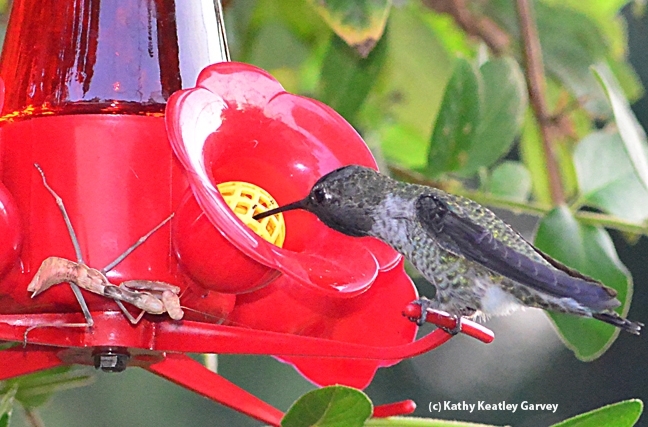
Hummingbirds eat insects and insects eat hummingbirds. Here a praying mantis lurks by a hummingbird feeder. It was quickly removed to another spot. (Photo by Kathy Keatley Garvey)
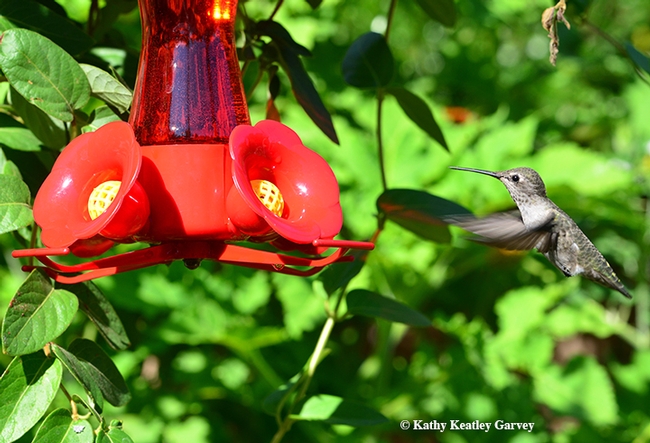
A hummingbird flies in for a quick burst of energy. It is best not to use red dye in a feeder; some companies make hummingbird feeders with red glass. (Photo by Kathy Keatley Garvey)
It's a Bird! It's a Plane! No, It's...
It's a bird! It's a plane! Is it Superman? No, it's a bird dropping. If you're growing sweet fennel (anise), you may have noticed what appear to...
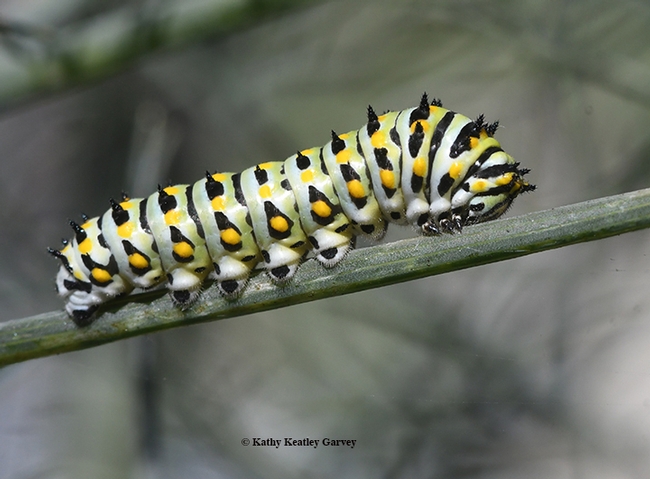
The iconic anise swallowtail caterpillar is a pale green with black bands containing orange spots. This is probably the fifth instar. (Photo by Kathy Keatley Garvey)
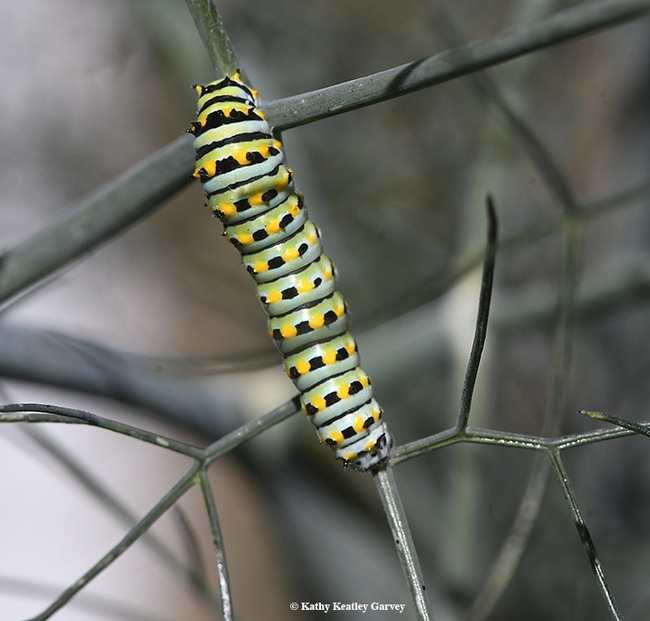
Dorsal view of an anise swallowtail caterpillar. (Photo by Kathy Keatley Garvey)
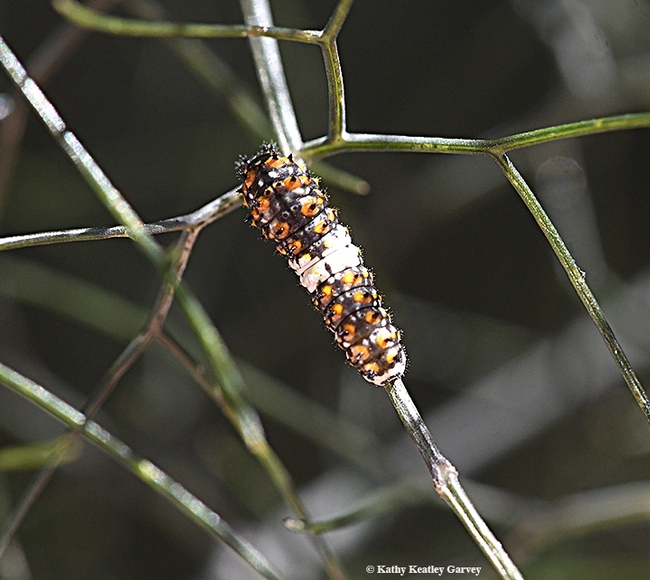
This younger larva of the anise swallowtail resembles a bird dropping. (Photo by Kathy Keatley Garvey)
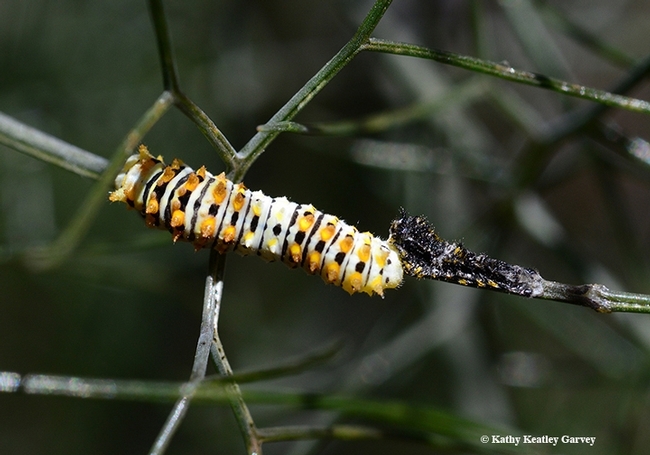
This anise swallowtail caterpillar is shedding its skin or molting, leaving its “bird dropping” skin behind. This is probably the third instar. (Photo by Kathy Keatley Garvey)
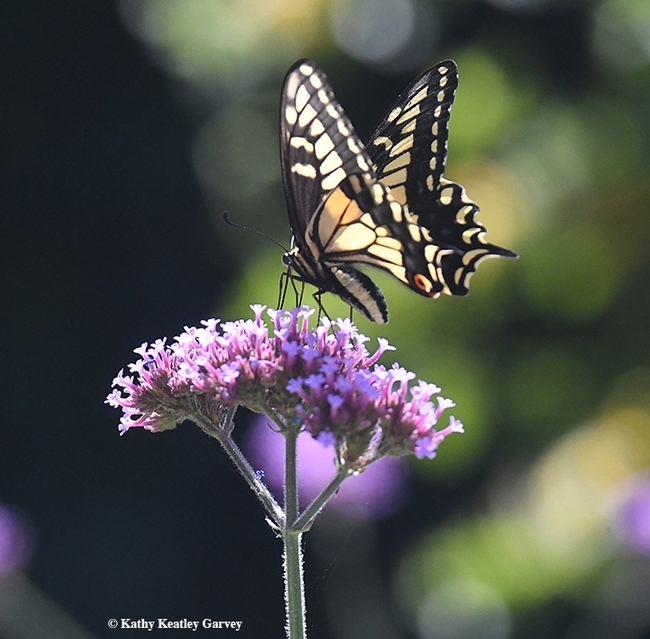
An adult anise swallowtail nectaring on Verbena. (Photo by Kathy Keatley Garvey)
UC sheep shearing school prepares students for gainful employment
“I tell my sheep shearing students, ‘You'll never be unemployed,'” said John Harper, UC Cooperative Extension livestock and natural resources advisor in Mendocino County. “And you'll never be poor.”
Shearers can earn $50 to $100 per hour, Harper said, and can start a business with a $3,000 investment in equipment.
“If they can learn how to shear sheep correctly, it's a great little business to get into,” Harper said.
The need for skilled sheep shearers in California and other parts of the nation has prompted the UC Hopland Research and Extension Center to host an annual sheep shearing school, where a diversity of students are introduced to a trade that allows them to work with their hands, out-of-doors, when and where they want.
Although sheep shearing is traditionally a male occupation, Harper said he encourages women to take the course.
“Women have a lower center of gravity. Strength is important, but so is hip rotation,” Harper said. “The sheep's skin is very loose and the blades are pretty powerful. The female students tend to be more cautious and we see fewer nicks.”
Beatrice Thomas, 41, is a typical student.
“I came to sheep shearing by way of dance and the arts,” Thomas said.
She left her Bay Area desk job about a year ago. “There wasn't a mind-body connection,” she said. “Forty hours at a desk, my body was aching.”
But sheep shearing was a completely different experience.
“This doesn't hurt the same way as sitting at a desk, because it feels vital. Every move is important. There's a dance. There's a rhythm. My whole spirit lit up,” Thomas said.
The 5,200-acre Hopland Research and Extension Center is home to a flock of about 1,000 sheep, which provide opportunities for scientists to study their role in land management. They also serve as a ready supply of animals for prospective new shearers to learn the craft.
“We teach students how to shear in a way that ensures the welfare of the sheep, produces a quality wool clip, and keeps the shearers safe,” Harper said. “We received a grant from the National Sheep Industry Improvement Association to purchase new shearing equipment. This allows the students to learn with brand new, state-of-the-art combs, cutters and hand pieces.”
The annual sheep shearing school at Hopland is the only intensive five-day course in the United States, said Hannah Bird, community educator at the research center.
“It brings people from all over the country and sometimes outside the country,” she said.
The week together helps build camaraderies amongst the newly trained sheep shearers. Hopland sheep shearing alums have created a Facebook group to stay in touch and refer jobs to one another. Several previous students are making a living a sheep shearing. One is Stephany Wilkes, a 2013 sheep shearing student who now runs her own sheep shearing business from San Francisco.
“People always ask me, ‘How can you run a sheep shearing business and live in the city?'” Wilkes said. “But there are actually a lot of sheep in the Bay Area, in Marin County, Solano and Yolo. I shear in Hayward and as far south as Gilroy. I go can go anywhere a car can.”
Lead instructor Gary Vorderbruggen said a key to sheep shearing success is a calm demeanor.
“Sheep don't need to be riled up. If you can be calm, and be safe, you will gain speed with experience,” Vorderbruggen said. “It's no different than a dance. It's like a square dance, except you're doing that square dance with an unwilling partner.”
Joining Harper and Vorderbruggen instructing the class in 2016 was Trevor Hollenback. He was first exposed to sheep shearing when visiting a friend's sheep farm in Austria.
“I realized this is a really skilled craft. It's amazing,” Hollenback said.
Hollenback quit his desk job and traveled to New Zealand for training, then returned to the Austrian farm for more practice. Back in the United States, Hollenback opened his own business and began shearing sheep in California and Arizona. He was tapped to be the instructor at Hopland because of his formal training in New Zealand.
“One of the most important things that the students can take away from this course is going to be sheep handling, how to move the sheep around, how to control the sheep on the board,” Hollenback said. “A lot of students came here with very little background in livestock. Footwork, positions, getting the pattern down – all the finer points in shearing – that comes with practice.”
The week-long sheep shearing school at Hopland will be held again in spring 2017. The class typically fills up within two hours of opening registration. Register interest on the UCCE Mendocino website to be notified when registration opens.
View scenes from the 2016 Sheep Shearing School at Hopland in the video below:


